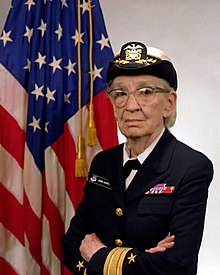Welcome to DU!
The truly grassroots left-of-center political community where regular people, not algorithms, drive the discussions and set the standards.
Join the community:
Create a free account
Support DU (and get rid of ads!):
Become a Star Member
Latest Breaking News
Editorials & Other Articles
General Discussion
The DU Lounge
All Forums
Issue Forums
Culture Forums
Alliance Forums
Region Forums
Support Forums
Help & Search
Bloggers
Related: About this forum"amazing grace" hopper-(December 9, 1906 – January 1, 1992- computer scientist, navy rear admiral
Grace Murray Hopper
Rear Admiral Grace M. Hopper, USN, Ph.D.
Nickname(s) "Amazing Grace"
Born December 9, 1906
New York City, New York, U.S.
Died January 1, 1992 (aged 85)
Arlington, Virginia, U.S.
Place of burial Arlington National Cemetery
Allegiance United States of America
Service/branch United States Navy
Years of service 1943–1966, 1967–1971, 1972–1986
Rank US-O7 insignia.svg Rear admiral (lower half)
Awards Defense Distinguished Service ribbon.svg Defense Distinguished Service Medal
Legion of Merit ribbon.svg Legion of Merit
Meritorious Service ribbon.svg Meritorious Service Medal
American Campaign Medal ribbon.svg American Campaign Medal
World War II Victory Medal ribbon.svg World War II Victory Medal
National Defense Service Medal ribbon.svg National Defense Service Medal
AFRM with Hourglass Device (Silver).jpg Armed Forces Reserve Medal with two Hourglass Devices
Naval Reserve Medal ribbon.svg Naval Reserve Medal

Grace Brewster Murray Hopper (December 9, 1906 – January 1, 1992), née Grace Brewster Murray, was an American computer scientist and United States Navy Rear Admiral.[1] She was one of the first programmers of the Harvard Mark I computer in 1944,[2] invented the first compiler for a computer programming language,[3][4][5][6][7] and was one of those who popularized the idea of machine-independent programming languages which led to the development of COBOL, one of the first high-level programming languages. She is credited with popularizing the term "debugging" for fixing computer glitches (in one instance, removing a moth from a computer[8]).
Owing to her accomplishments and her naval rank, she is sometimes referred to as "Amazing Grace".[9][10] The U.S. Navy Arleigh Burke class guided-missile destroyer USS Hopper (DDG-70) is named for her, as is the Cray XE6 "Hopper" supercomputer at NERSC.
. . . .
In 1943, during World War II, Hopper obtained a leave of absence from Vassar and was sworn into the United States Navy Reserve, one of many women to volunteer to serve in the WAVES. She had to get an exemption to enlist; she was 15 pounds (6.8 kg) below the Navy minimum weight of 120 pounds (54 kg). She reported in December and trained at the Naval Reserve Midshipmen's School at Smith College in Northampton, Massachusetts. Hopper graduated first in her class in 1944, and was assigned to the Bureau of Ships Computation Project at Harvard University as a lieutenant, junior grade. She served on the Mark I computer programming staff headed by Howard H. Aiken. Hopper and Aiken coauthored three papers on the Mark I, also known as the Automatic Sequence Controlled Calculator. Hopper's request to transfer to the regular Navy at the end of the war was declined due to her age (38). She continued to serve in the Navy Reserve. Hopper remained at the Harvard Computation Lab until 1949, turning down a full professorship at Vassar in favor of working as a research fellow under a Navy contract at Harvard.[19]
UNIVAC
In 1949, Hopper became an employee of the Eckert–Mauchly Computer Corporation as a senior mathematician and joined the team developing the UNIVAC I.[17] In the early 1950s, the company was taken over by the Remington Rand corporation, and it was while she was working for them that her original compiler work was done. The compiler was known as the A compiler and its first version was A-0.[20]:11
. . . .
https://en.wikipedia.org/wiki/Grace_Hopper